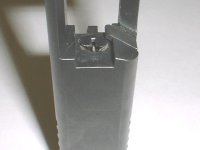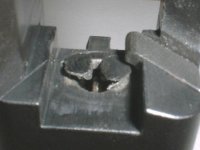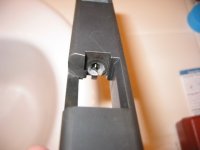You are using an out of date browser. It may not display this or other websites correctly.
You should upgrade or use an alternative browser.
You should upgrade or use an alternative browser.
Snap caps and dry firing
- Thread starter charlesc
- Start date
Most center fire pistols can be dry fired without effectively damaging them. Some have design quirks that can cause issues if they are dry fired on empty chambers. The XD line is an example. The vertical pin in the slide assembly can break as a result of dry fire.
Personally, I do a LOT of dry fire. I use snap caps for all of my dry fire
, because... why not? They're $15 or so, and last forever.
Personally, I do a LOT of dry fire. I use snap caps for all of my dry fire
, because... why not? They're $15 or so, and last forever.
Biff Tannen
New member
I swear by the snap caps.
Great investment!
Great investment!
Ive had a couple of issues with the "red plastic" type, specifically, in a couple of .308's. Never had any issues with the A Zooms.
I use them when I dry fire as well, with pretty much everything. I figure they cant hurt, and they also offer another level of safety, as you cant have a live round in the chamber, if you consciously load the snap cap.
In 50+ years of shooting, Ive only ever broke one firing pin. It was in an M1A, that was heavily shot and dry fired without a snap cap.
I use them when I dry fire as well, with pretty much everything. I figure they cant hurt, and they also offer another level of safety, as you cant have a live round in the chamber, if you consciously load the snap cap.
In 50+ years of shooting, Ive only ever broke one firing pin. It was in an M1A, that was heavily shot and dry fired without a snap cap.
100% on the need for snap-caps (in fact, if I loan my firearm at the range I CLEARLY ask/tell the recipient DON'T dry fire my gun not to sound like an a-hole  ).
).
Ironically there was a good YT vid released just yesterday concerning same:
https://www.youtube.com/watch?v=hVL0xoNMnyA
Ironically there was a good YT vid released just yesterday concerning same:
https://www.youtube.com/watch?v=hVL0xoNMnyA
AK103K said:Ive had a couple of issues with the "red plastic" type, specifically, in a couple of .308's. Never had any issues with the A Zooms.
Agreed, the Tipton red plastic snapcaps aren't the best. They have a realish brass base/rim but they don't last like the A-Zoom ones do.
While this is true for most currently produced centerfire pistols, it is not true for a great number of revolvers produced in the past and still widely available. Many revolvers have the firing pin mounted on the hammer, rather than the frame, and dry firing may damage these. A few dry fires probably won't hurt them but the more you do the greater the chance for damage. Centerfire revolvers with frame mounted firing pins are okay to dry fire. It's nearly a universal rule that dry firing a rimfire gun is a bad idea.Most center fire pistols can be dry fired without effectively damaging them.
Many of today's centerfire handguns are striker fired and don't use a traditional hammer. AFAIK, these can all be safely dry fired. The 1911-style pistols (which do use a hammer) can be safely dry fired if you thumb the hammer back yourself. Racking the slide and using the slide stop lever to allow it to proceed forward over an empty magazine can cause some issues, including botching a good trigger job. It won't hurt the firing pin other than ordinary wear.
If checking out another person's handgun (including those in gun stores), always ask before dry firing even if you know it won't hurt the handgun. When I'm checking the action of a used revolver, I never actually dry fire it. I cycle the action while keeping my thumb on the hammer and let the hammer down slowly. I get a good idea for the action without dry firing.
BTW, snap caps cushion the shock of the firing pin hitting and reduces the chance of breakage.
I'm guessing this is a dumb question,
There are only two kinds of dumb questions- the first is one you knew the answer to, and asked anyway, and the other is the question you did not know and did not ask, for whatever reason ....
but can you use spent brass as a snap cap??
Yes, until the primer (or rim, for rimfire) gets so smashed it is not cushioning he blow anymore ......
S & W Model 66, or 17's etc. should NEVER be dry fired without a snap cap.
Years ago, one of my first revolvers was a Model 66 S & W revolver. Dry firing it one day, firing pin nose goes flying across the living room like a BB out of a Daisy air rifle, ricocheting off of a couple walls. Lesson learned - read manual more - fool with firearm less. Can an EMPTY firearm hurt you? - DAMN RIGHT - if this was pointed towards someone or something I didn't want to destroy.
Spent brass can make an adequate snap-cap, - puch the primer out and glue in a piece of pencil eraser in it's place. Plastic snap caps just disintegrate after a while - buy the aluminum ones.
Years ago, one of my first revolvers was a Model 66 S & W revolver. Dry firing it one day, firing pin nose goes flying across the living room like a BB out of a Daisy air rifle, ricocheting off of a couple walls. Lesson learned - read manual more - fool with firearm less. Can an EMPTY firearm hurt you? - DAMN RIGHT - if this was pointed towards someone or something I didn't want to destroy.
Spent brass can make an adequate snap-cap, - puch the primer out and glue in a piece of pencil eraser in it's place. Plastic snap caps just disintegrate after a while - buy the aluminum ones.
My primary use of snap-caps is to relieve the spring tension of the hammer or striker spring. Prefer to keep my arms under the least amount of tension/duress. Otherwise dry firing with the snap-cap is limited to feeling the trigger. Also not fond of the idea of the firing pin or striker slamming within the slide or bolt that may eventually cause burrs or something to crack.
Like many I’m not a real fan of reading manuals unless the gadget is something new to me. Pictorials and exploded views are more to my liking. As a kid I assembled model kits largely from the images without reading, this is the same when I assembled kits in a foreign country in a foreign language, no reading required.
The snap-caps I use most are the Italian made type usually having a brass base and red plastic body. IMO the spring backed brass button that mimics the primer is a good design giving good life and cushions the firing pin strike well.
My experience with the blood red colored aluminum bodied A-Zoom has not been good. In my long arms feeding from the mag is not as smooth as a brass cartridge or plastic bodied snap-cap. The A-Zoom is said to be CNC made but QC is still needed IMO. I have this brand in 7.62x39 (AK round) and it would royally jam in my AK’s and my Ruger Mini Thirty. The bolts will not close by about 1/8”. Dial caliber measured the snap-caps as much as possible with no difference noticed. Looked online and found a forum thread a mile long about the A-Zoom issue. Like me they were in bewilderment but eventually found the problem. The angle of the shoulder was incorrect.
I was fortunate to be able to exchange my defective A-Zoom’s with a familiar vendor at the gun show even though I didn’t purchase the caps from him. Can’t remember the entity at the show I got them from.
Like many I’m not a real fan of reading manuals unless the gadget is something new to me. Pictorials and exploded views are more to my liking. As a kid I assembled model kits largely from the images without reading, this is the same when I assembled kits in a foreign country in a foreign language, no reading required.
The snap-caps I use most are the Italian made type usually having a brass base and red plastic body. IMO the spring backed brass button that mimics the primer is a good design giving good life and cushions the firing pin strike well.
My experience with the blood red colored aluminum bodied A-Zoom has not been good. In my long arms feeding from the mag is not as smooth as a brass cartridge or plastic bodied snap-cap. The A-Zoom is said to be CNC made but QC is still needed IMO. I have this brand in 7.62x39 (AK round) and it would royally jam in my AK’s and my Ruger Mini Thirty. The bolts will not close by about 1/8”. Dial caliber measured the snap-caps as much as possible with no difference noticed. Looked online and found a forum thread a mile long about the A-Zoom issue. Like me they were in bewilderment but eventually found the problem. The angle of the shoulder was incorrect.
I was fortunate to be able to exchange my defective A-Zoom’s with a familiar vendor at the gun show even though I didn’t purchase the caps from him. Can’t remember the entity at the show I got them from.
Last edited:
I use them also, peace of mind for the investment in pistols. A pack is around $15 and for my .40, one cap lost the silicone insert, two I gave to a buddy and two I have been using for a couple of years. They are getting roughed up from the extractor but should be usable for years longer.
biohazard313
New member
i was told striker fired pistols it doesn't hurt. hammered ones it can cause issues.
" i was told striker fired pistols it doesn't hurt. hammered ones it can cause issues."
Da! My opportunity to show and tell.
My opportunity to show and tell. I really don’t know what caused the broken breach face on Glock’s. Some say excessive dry firing without a snap-cap others say a factory defect. Or another thought is dry firing without a snap-cap at least contributed.
I really don’t know what caused the broken breach face on Glock’s. Some say excessive dry firing without a snap-cap others say a factory defect. Or another thought is dry firing without a snap-cap at least contributed.
Da!



